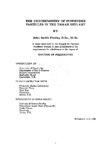Geochemistry of suspended particles in the Tamar estuary
| dc.contributor.author | Findlay, John Smith | |
| dc.contributor.other | School of Geography, Earth and Environmental Sciences | en_US |
| dc.date.accessioned | 2011-06-28T15:17:14Z | |
| dc.date.available | 2011-06-28T15:17:14Z | |
| dc.date.issued | 1990 | |
| dc.identifier | Not available | en_US |
| dc.identifier.uri | http://hdl.handle.net/10026.1/514 | |
| dc.description.abstract |
ICP analyses of total rare earth element (REE) abundances in intertidal sediments and suspended particles from the Tamar Estuary show little variation in REE concentrations along the estuary and only minor fractionation relative to standard shale. Fe, Mn, Cu, Zn, Ni & Co abundances in the estuarine suspended particles show significant variations in the turbid upper estuary. Acid leachable REE display different shale normalised patterns with slight enrichment of the mid to heavy REE. Sediment porewater analyses confirm the diagenetic mobility of the REE and show significant heavy REE enrichment consistent with their derivation from a non-detrital source. Detailed studies of suspended particles in the turbidity maximum zone reveal the importance of physical processes in the immediate local control of the bulk chemical composition of the suspended particles. Settling experiments performed on particle samples from the turbidity maximum show clear distinctions between populations of particles which are tidally resuspended versus those which remain permanently in suspension. Trace metal-Al ratios and shale normalised REE patterns in the two fractions are consistent with greater non-detrital content in the permanently suspended particles. Modelling of mixing between detrital REE and the riverine REE removed from solution in the low salinity zone indicates that a significant proportion of the leachable particulate REE may be derived from a non-detrital source. Budget calculations using annual fluxes of dissolved REE, Fe, Cu, Ni & Zn and riverine sediment supply confirm that significant modification of particle composition due to uptake of non-detrital metals is likely, but indicate that not all the sediment supplied to the estuary may participate in the chemical scavenging processes. | |
| dc.language.iso | en | en_US |
| dc.publisher | University of Plymouth | en_US |
| dc.title | Geochemistry of suspended particles in the Tamar estuary | en_US |
| dc.type | Thesis | |
| dc.identifier.doi | http://dx.doi.org/10.24382/3763 | |
| dc.identifier.doi | http://dx.doi.org/10.24382/3763 |
Files in this item
This item appears in the following Collection(s)
-
01 Research Theses Main Collection
Research Theses Main


